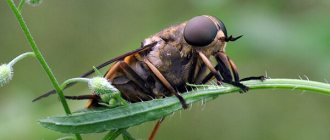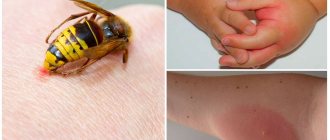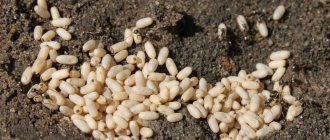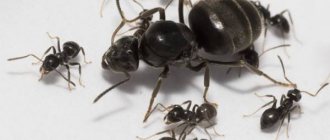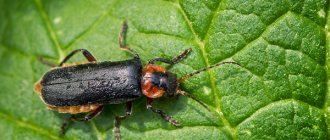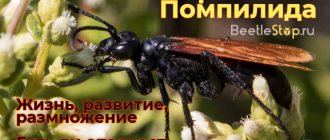What does a wasp look like?
The wasp can be mistaken for its closest relative, the bee.
Wasps belong to the order Hymenoptera. This also includes bees, bumblebees, and ants. But wasps have a number of differences; in other articles we talked about bees and their characteristics. Today we will look at interesting facts about wasps. The structure of the wasp's body makes it clear why these insects are classified as the suborder of stalked bellies. The thorax and abdomen of the wasp are separated, appearing in two parts. The beautiful narrow waist of girls and women is called the “wasp waist” precisely for this reason.
Important: Thanks to the structure of the wasp, the popular expression “wasp waist” came about, personifying the slimness and beauty of the female figure.
The wasp hardly thinks about the beauty of her body, but such a structure gives her other advantages. For example, due to its anatomical structure, a wasp can effortlessly sting its victim from any angle. This helps the wasp win fights with other, larger insects.
You can unmistakably identify a wasp by its bright color. The insect's body is divided by black and yellow stripes of bright color. This type of wasp is most often found in our latitudes; the family is called paper wasps. But there are other types of wasps, for example:
- Burrowing wasps
- Spangled wasps
- Typhia
- Road wasps
- Scolia
- Hornets
Not all wasps are black and yellow. Spangled wasps are emerald in color with a metallic sheen. Road wasps are black with red spots, less often they have white or yellow spots. Typhus wasps are dark in color with reddish legs. The sizes of wasps can also be different:
- Typhias reach sizes of 1-1.5 cm;
- Giant wasps can have a body length of 3 to 5 cm;
- Spangles are small, body length no more than 1.5 cm;
- Paper wasps are the same size as bees.
- Hornets reach sizes of 2.5-3 cm.
Depending on the species, wasps lead a different way of life; they can live in tree hollows or burrows. Below are photos of different types of wasps.
Spangled wasp
Road wasp
Typhus wasp
This is what a hornet looks like
What determines the lifespan of wasps?
Insects are not among the long-livers. The lifespan of a wasp depends on environmental factors and its species. Social insects living in families have an internal hierarchy, which implies not only the distribution of responsibilities, but also affects the duration of existence.
Social wasps
The insect colony is distinguished by a clear division of responsibilities and importance in the life of the family. Three types of adults coexist in the nest:
- the queen, which lays eggs and runs the colony;
- infertile females are working insects;
- males capable of fertilization in a certain season.
Polite or paper wasps are the most famous representatives of the subfamily. In the spring, young queens look for a place for a nest, which they begin to build on their own. To build a house, they use chewed grass and tree bark. At the beginning of summer, the first working individuals are born; they are similar to the queen, but are smaller in size - 18-20 mm versus 25 mm. The lifespan of a young wasp is about 2 months.
At the end of summer and in September, males and females grow up in special cells and are capable of giving birth to offspring. They fly out of the nest and mate. With the onset of cold weather, males fly away from home and die. They will live 2-3 months. Old poppies, along with young ones, mate to procreate. With the approach of cold weather, future queens hide under the bark, in crevices and plant remains, where they will spend the winter in a state of diapause. The lifespan of the uterus is 2-4 years.
Hornets are the largest representatives of social wasps. Males live for several days or weeks, depending on the time before swarming begins, because after mating they die. Working females can live 1-2 months, many of them die during flights for food. The longest life of the queen hornet is the fertilized female, which will survive the winter and give rise to a new family. The lifespan of the uterus is 1 year.
Solitary wasps
Insects that live alone make nests in various ways. All solitary females are queens and their lifespan is 1 year. Some species (burrowing and road wasps) dig larval chambers in which they leave food - paralyzed spiders or caterpillars.
Other species (scolia, typhus, German wasps, and wasps) parasitize spiders, beetles, and other insects. They lay eggs in the body of a paralyzed victim. Flower and sand wasps build nests with one or more isolated cells. An egg is laid in them and food is left for the larva. The cell is sealed. The grown-up individual gnaws its way to freedom.
The life cycle of wasps covers only the warm season. Few representatives of this species survive the winter due to frost and natural enemies.
Wasps. Do they benefit people?
If you are stung by a wasp, it will be painful, and your body may react incorrectly. The composition of wasp venom is almost no different from bee venom. After long studies of toxic substances, scientists have established that wasp venom is more allergenic and more often causes dangerous allergic reactions in the body. As you already understand, we will talk about the effect of wasp venom on a person through a bite.
Is there any benefit from a wasp sting? Can the poison have a beneficial effect? Let's look at the benefits of a wasp sting for humans.
It is impossible to answer unequivocally. Due to the fact that bee and wasp venoms are similar in composition, those who like to use bee products as medicine think that a wasp sting is as beneficial as a bee sting, and their venom can help against diseases.
If we follow this hypothesis, then the only difficulty before the practical use of wasp toxic substances in medicine is that the raw materials are very difficult to obtain.
Bees are specially bred and their venom can be obtained in large quantities in the apiary using a well-established method, and you will have to go to the found nest for the wasp venom. Second option: organizing mass construction of nests is possible.
Scientists have studied the poisonous substances of the wasp and imagine how they behave with various organs and tissues. The effect of the poison, its usefulness or damage directly depend on the reaction of the organism itself to the bite.
In the end, even doctors and toxicologists have not made a final decision on whether wasp stings are beneficial.
The poison contains many stimulating and tonic components, substances that stimulate metabolism, but their isolation is difficult and unreasonable, because now safer analogues can be found on the market.
In addition, thanks to wasps, there are fewer insects that eat fruits or plants. They exterminate pests such as aphids, flies, fleas, caterpillars, bedbugs and others. One individual can destroy up to three dozen pests per day.
And yet, does wasp venom bring benefits or not? A bite will not bring any benefit to a person. But doctors officially use wasp venom. It is used in the manufacture of special vaccines for those susceptible to allergies and in products that are intended to reduce sensitivity to poisons and bites.
And in Europe, scientists are researching wasp venom as a drug that can treat cancerous tumors. And there remains hope that they will one day achieve a positive result.
Wasp venom can do more harm than benefit. It contains allergenic components that are unsafe for the human body. These substances may lead to:
- to increased temperature and mild malaise;
- to difficulty breathing;
- to urticaria;
- to inflammation and swelling;
- to a headache.
The damage from a wasp sting also lies in the sensitization it can cause. This is an increased sensitivity to subsequent bites. In other words, when the first bite causes a serious reaction, subsequent bites will lead to severe complications and death. A large number of bites leads to subcutaneous hemorrhage, necrosis and damage to internal organs, and kidney failure may occur.
In the most severe cases, a wasp sting may be accompanied by confusion and Quincke's edema. The bitten area will begin to rapidly swell, and if at first the size of the tumor is small, then later they increase, and the entire limb may swell.
The worst and main danger of a wasp sting is anaphylactic shock. This is how the organisms of people who are very sensitive to wasp venom react. A person can die due to anaphylactic shock. It develops at an incredible speed; most often the patient does not have time to be brought to the hospital.
What can you do to alleviate the consequences and not cause yourself even more harm?
- wash the bite area;
- carefully remove the sting;
- disinfect the wound;
- apply ice to the damaged area;
- take any antihistamine.
There is little benefit from a wasp sting, but it can cause harm. How it will act and what consequences it will incur depends on how susceptible the body is to insect bites. In most cases, the bite will be accompanied by simply unpleasant or painful sensations.
- Don't confuse wasps and bees. The latter bring honey, therefore they are considered very useful insects for people. And wasps are predators, so they don’t bring honey, but eat flies, caterpillars and other insects. Their main benefit is that a person can study their life from a scientific point of view. Each type of insect is useful for humans in this regard.
- There can be no doubt, wasps are useful, wasps bring honey, wasp honey is tasty and healthy. In nature, everything is interconnected, every animal, insect, etc. fulfills its function and role. In addition to honey, wasps pollinate flowers and plants.
- In nature, every insect, plant, animal necessarily brings benefits. I have some doubts about honey from Wasps. But wasps really help us in pollinating plants and killing harmful insects. It’s true that they bite very painfully.
- Wasps bring both benefit and harm, so they are necessary and important in nature. As for the harm, they can bite a person, and also spoil some fruit trees by feeding on the juice of the fruit. But as for the benefit, it is obvious and more pronounced: wasps pollinate some plants, wasps eat insect pests.
- She herself wanted to destroy wasp nests: she even found 2 on her site. But I read it and realized that they are beneficial: they pollinate the garden and vegetable garden. Wasps also destroy flies, caterpillars and other harmful insects with which wasps feed their larvae. They also spoil fruits and berries by sucking the juice out of them.
- Wasps cause both harm and benefit. Wasps feed on the juice of ripe pears, spoiling grapes in the process. They bite very painfully if disturbed. Wasps also perform a useful function: they feed on some insects, garden pests, and pollinate some plants.
Rules for wasp control
If you find a nest of wasps in your dacha, then dealing with them is not at all difficult. The main thing is to take care of your safety in order to protect yourself from the bites of these insects. Procedure:
- Prepare clothes with long sleeves. Clothing must be tight, otherwise the bites will be felt through the layer of fabric.
- With the onset of darkness, wasps are not particularly active, so this period is most suitable for controlling wasps.
- If one wasp does bite, you should not kill it, since it can secrete a special substance that increases the aggression of the entire swarm.
- If you were unable to cope with the wasps the first time, then you can continue the activity only after the insects have calmed down.
The process of destroying wasps requires that there is no one nearby who lives in the country. It is better to send all other family members, along with pets, for a walk. And most importantly, if it is decided to destroy wasps, then the matter must be completed, otherwise the wasps will bite everyone who is near them.
Small insect exterminators
Adults feed on nectar and fruit extract. But the larvae need constant replenishment of protein. To do this, wasps prey on other insects, including flies, mosquitoes, spiders, aphids, and garden pests.
A flexible body structure, powerful jaws, a sting equipped with poison - nature generously endowed the “minke whales” with all this for a reason. Thanks to this arsenal, they can sting the enemy from almost any angle. They deal with small, weak opponents with the help of mandibles, crushing the skull or chitinous cover into small pieces.
Wasps use a sting on stronger insects, which, unlike bees, they freely remove after an attack. Depending on the species, the composition of the poison differs and can either simply paralyze the victim or provoke its death.
Wasps play a significant role in nature by destroying garden pests. For example, the burrowing single Larra wasp helps in destroying a dangerous pest - the mole cricket. She is absolutely indifferent to other insects and animals.
Larra hunts in a very unique and masterly manner. The insect drives the pest out of the ground and injects its poison into it through its sting. The wasp lays its egg in the paralyzed victim. The mole cricket acts as an incubator for the development of offspring. While the larva develops, the donor remains alive, supplying the young individual with all the necessary nutritional components.
But slender insects help fight not only mole crickets. Giant scolia, in addition to pollinating flowers, regulate the number of bronze beetles, beetles, and rhinoceros beetles. Like the Larra wasp, Scolia lays eggs on its prey.
We must not forget that the functions of wasps in nature include pollination of plants and flowers, which is important for their development and reproduction.
Without knowing it, wasps indirectly protect other insects. Hunting abilities, aggressive disposition, and deadly sting force other representatives of the fauna to refrain from contact with the striped predator. Weaker individuals took note of this attitude towards the wasps and “borrowed their colorful outfit.”
Perhaps no insect has as many imitators as wasps. Striped colors help protect flies, hoverflies, beetles, butterflies and many other harmless creatures from birds and predators.
How long do wasps live?
Wasps are annoying, brightly colored insects. How long different representatives of wasps live depends on the species and the insect’s place in the family hierarchy.
Lifespan
Various representatives of the wasp family can live from a couple of months to several years. Species and external natural factors influence how long wasps live. Wasps are conventionally divided into solitary and social; their life spans are different.
Social ones live in a strict hierarchical system, like bees. Singles lead an isolated existence.
Uterus
The long-lived female among social wasps of all species lives for several years. All summer, the queen actively replenishes the population of the nest, continuously laying eggs. Towards the end of August, new, large cells for special offspring appear in the nest. From these cells young females and males hatch.
Before the onset of cold weather, they mate, after which the males die, and the future mothers of the family look for a place to winter. Females hide under bark, remnants of grass, and leaves. How many years the queen will live depends on a well-chosen location. Smart and lucky ones will survive 3-4 winters.
Working individual
Workers are the main population of a wasp hive, females who are not capable of reproduction. The working individual lives for about two months, the composition is constantly updated due to the continuous work of the uterus. By the end of summer, construction is no longer required; the worker wasps have completed their function. They restore order in their summer residence by eating larvae that have not yet been born.
After the act of cannibalism they set off on a journey. With the onset of the first frost, everyone dies. There are theoretical data according to which the queen of some species of the wasp family leaves the nest, dying along with the workers.
Males
In the tough wasp matriarchy, males are not particularly favored. They are born to fertilize females at the very end of summer; with cold weather, certain death awaits them. The lifespan of a male is about a month, with a maximum of 40 days. It all depends on the time of frost.
Species dependent
Solitary species do not live more than six months. All summer the female is active. She lays eggs and obtains food for herself and the larvae. Some species of solitary road wasps lead a “thieving” lifestyle, stealing the prey of their sisters for their own offspring. When the cold comes, both females and males die. New wasps will emerge from their burrows only in the spring.
The lifespan of social species depends on gender and external factors. Life expectancy data by gender:
- working females live 2 months
- drones – 40 days
- uterus – 1-4 years
Enemies and danger to life
Wasps are equipped with a magnificent weapon - a poisonous sting, but they themselves become victims.
Other insects and larger enemies attack: birds and mammals.
- The most dangerous enemies of wasps are... the wasps themselves. More precisely, one of the wasp species is hornets. Hornets are the largest and most numerous, real killers, capable of completely encircling an entire settlement, destroying all their fellow creatures living in it.
- One of the natural enemies of wasps is also the paradoxical fan beetle. The larvae of this beetle attach to adult individuals and end up inside the wasp colony. In the hive, they penetrate the cells and feed on the larvae. Having emptied the cell, the fantail pupates right in the cradle of its victim. The adult that emerges from the cocoon leaves the nest.
- The wasp society may be weakened due to the premature death of the queen. Then the nest can be destroyed by ants. They will profit from the remaining larvae. They will not disdain weak or sick individuals.
- The closer the cold, the slower and weaker the insects. In early autumn and spring, they easily become prey for birds or bears.
- The most dangerous enemy of wasps is people. If a wasp house turns out to be close to any housing, then in the near future they will prefer to get rid of it, on their own or with the help of specialists.
Life after the bite
During one attack, the wasp can sting several times in a row, as long as the supply of poison allows. The wasp's sting has no jagged edges, thorns, or irregularities. It is removed from the victim's body without resistance, allowing the attack to continue. Having stung, the insect does not die unless a person or large animal crushes the wasp during the bite. An individual that dies during an attack leaves a stinger at the site of the bite; it must be removed.
Why are wasps needed in nature: answers from entomologists
A huge number of small and large creatures live in the vicinity of humans.
Insects flutter in the air, birds sing in the crowns of trees, amphibians and reptiles hide somewhere in the grass.
It is pleasant to listen to the trills of a nightingale, you want to fly with the butterfly, and you have to escape from stinging insects.
Their bites are painful and cause allergies in many. You can put up with bees bringing honey to your hives.
But why are wasps needed in nature: expert answers will help shed light on some mysteries.
The role of wasps in nature
Having once experienced a painful, aching bite on yourself, and having discovered a sting ingrained into the body, you involuntarily lament why wasps are needed in nature.
Offended children will immediately say that small insects are completely useless and it’s time to destroy them.
However, biologists who know much more about the fauna world will not agree with this statement. They have prepared a lot of arguments explaining why wasps are useful in nature.
Having learned the compelling arguments, you will be able to, if not fall in love with the striped inhabitants of the meadow, then treat them with respect.
Every individual in nature is useful in some way. The wasp, although outwardly unattractive when compared with colorful butterflies, turns out to be needed by the community.
The main food of the striped insect is other representatives of this class.
Moreover, the predator often attacks individuals that are significantly larger than it in size.
Social wasps go to different places in search of food, looking for pests of agriculture, gardening, and forestry.
Some species choose unusual prey for themselves.
Ammophila eats cutworms that can destroy hectares of farmland. The tiny spilomena, which resembles a small bee, actively fights thrips, which pose a threat to cultivated plants. Scolia feeds on chafers. She also eats their larvae.
Larra, deftly digging holes, finds mole crickets underground and destroys them. Scientists often compare wasps to ants.
Insects of both groups are the best natural orderlies. Without their efforts, nature would begin to wither from the invasion of pests.
We suggest you familiarize yourself with what household kitchen scales are for, how they work and what they are like.
Often, in areas where there are many parasitic insects, special plants with an expressive aroma are planted to attract wasp families.
Plantings of marigolds, dill, caraway seeds, and tansy are suitable as bait. Do not forget that the function of the wasp in nature is even broader.
They are involved in other important processes:
But this list does not fully reveal the significance of the wasp in nature. In Mexico, there are individuals capable of producing honey.
It is different from the bee. There are fewer nutrients in the aspen product, but the local population sometimes eats it.
Having learned what wasps are needed for in nature, it is worth noting their harm. It is less significant, but present. Wasps that have settled on a summer cottage cause damage to the berry harvest. They drink juice from ripening grapes and eat raspberries.
They have a special passion for pears. Wasps destroy harmful insects, but do not disdain beneficial ones. They are capable of destroying bee colonies that people keep in their apiaries.
Some wasps and hornets use tree bark to build their own nest. They gnaw away the tender bark, destroying young seedlings.
Often a wasp builds its house in a secluded place, as close as possible to human habitation.
She chooses abandoned houses, barns, and attics to move into. The proximity to people does not frighten her, because the predator is always ready to defend herself.
And a person has to be afraid of meeting her, because the bites turn out to be unpleasant and sometimes dangerous.
Seeing an approaching adult or child, the wasp does not react to them until it notices the waving of its arms.
She expects an attack, so she immediately begins to attack. Reacts aggressively to bright clothes and the scent of perfume. It bites painfully, piercing the body with a sting.
Releases poison that is rich in histamine.
The substance causes allergies in many people. Wasp stings are especially dangerous for children. If they are bitten by several hornets at once, also belonging to this group, medical attention is urgently required. There are known cases of death after an attack by a family of wasps or hornets.
Unpleasant and dangerous manifestations after a bite:
- Quincke's edema;
- temperature increase;
- swelling of the skin.
In rare cases, dizziness may occur after an insect attack.
It happens that a person loses consciousness and faints. Even anaphylactic shock occurs when a wasp family attacks men and women.
The wasp often visits landfills and cesspools, looking for tasty food. Many bacteria, dangerous microorganisms, are attached to the paws.
Benefit or harm
A person sees and evaluates only a small part of what wasps can do. In most cases, attention is directed to the negative qualities of insects. Often a person fights wasps without thinking about the consequences, just because they spoil grapes, eat berries, and can potentially sting painfully.
Harm to humans
The danger of a bite is always put first. Since people most often encounter social, paper wasps, we are talking about them. The insect pierces the skin with a sting and injects poison, which instantly causes a reaction in the body in the form of redness, swelling, and pain. With weak immunity or the presence of individual intolerance, an ordinary wasp bite turns into serious health complications. Allergy manifests itself not only as local irritation of the skin, but also as a deterioration in well-being.
- headache;
- dizziness;
- changes in blood pressure;
- loss of consciousness;
- increased body temperature;
- nausea;
- vomit;
- diarrhea;
- loss of orientation;
- convulsions;
- swelling of the larynx.
In severe cases, the reaction develops instantly; swelling of the larynx can occur in just 5 minutes. In the absence of qualified help, a person dies. The situation is extremely rare, but it does happen. Severe allergies can occur even in those people who have previously been repeatedly exposed to insect bites and have always tolerated them easily.
In various sources there is a statement that wasps attack only in case of danger to their own life, but they can regard any human movement as aggression and rush to attack. A small insect can simply not be noticed, stepped on or pressed. A bite will definitely follow. The situation is extremely dangerous when a person approaches a wasp nest; a massive attack of insects causes severe allergies.
To protect yourself from troubles in the warm season, you need to avoid making sudden movements when you see a wasp, behave carefully in nature, and always carry an antihistamine with you.
Wasps in a summer cottage
Adults feed on nectar, bee honey, juices of ripe fruits, and some vegetables. And also lemonade, kvass, beer. Protein food is required to feed the larvae. Wasps can often be found near meat and fish. In the wild they hunt spiders, small and large insects. This is where the beneficial and harmful qualities of insects appear.
At a summer cottage, the nest and a large number of striped individuals are disposed of to avoid being bitten and damaging the crop. Insects are especially dangerous for grapes. What wasps do with berries: they simply pierce them and suck out the juices. But they have the peculiarity of not eating away one, but damaging different ones. At the puncture site, the berry begins to deteriorate and rot. Several dozen wasps in a vineyard can cause significant damage to the crop. To combat insects on grapes, people use special bags, traps, and insecticides.
It is dangerous for a wasp family to settle in a country house where there is an apiary. Predators are not averse to getting their fill of honey, and the bees are carried away to their larvae for food. A massive attack can destroy a bee hive in half an hour. To catch predators, beekeepers place traps and destroy nests mechanically - pour boiling water over them and burn them.
Wasps in the country
However, in a summer cottage, wasps bring benefits, even more than harm. They destroy a huge number of insects, which humans call agricultural pests.
The venom of the Brazilian wasp has become a real medical discovery because it can kill cancer cells. In the future, it is planned to produce a unique medicine that will help defeat oncology of the genital organs and bladder.
Why don't people like wasps?
If the benefits of striped insects are not always noticeable, then people feel the full extent of the harm from them. It manifests itself not only in bites, but also in eaten fruits and berries.
Spoiled Harvest
After pollination of plants, insects lay claim to the fruits. They prefer soft, sweet fruits. A large swarm can damage a large number of apples, pears, plums, and raspberries. Grapes are especially affected. Wasps, with their strong mandibles, easily gnaw through the skin and drink the juice. Damaged berries impair the presentation of the bunches.
Various methods are used to control insects:
- hang baits;
- destroy nests;
- grapes are treated with chemicals;
- The bunches are wrapped in special bags.
Bee exterminators
Beekeepers experience the greatest harm from wasps. Predators are attracted to the aroma of sweet honey. They sneak into the hive and eat the supplies prepared by the bees. Lack of food weakens the brood. In addition, a battle ensues between bees and wasps, in which many honey plants die. A strong family is able to fight off paper wasp invaders, but a weak one may not be able to cope.
The attack on the apiary by the largest representatives of the wasp family - hornets - turns out to be critical. Striped giants are significantly larger than bees. They easily tear apart prey, grabbing it on the fly. A hive with honey and insects becomes an ideal food source for them.
Another enemy of beekeepers is the philanthus or bee wolf. This is a solitary wasp of small size 10-17 mm. She paralyzes her victim with a stinger blow under the chin. This place is not protected by chitin and the poison quickly enters the main nerve ganglion. Nectar is very harmful to the offspring of the philanthus. He carefully crushes the killed victim with his paws, squeezing out the contents of the abdomen. The nectar is eaten by the adult, and the bee's body is given to the larvae.
A wasp sting is painful and dangerous
Insects use two types of self-defense. The first is the repellent coloring. It signals to birds and reptiles that the wasps are poisonous. As an active defense, they use a sting located at the end of the abdomen. Over the years of evolution, the female's ovipositor has turned into a hard tube. The smooth organ does not get stuck in the skin, so the insect is capable of inflicting many bites. The sting is connected to a gland that produces poison. The chemical composition of the toxic substance varies depending on the type of wasp. In case of danger, the insect releases a special enzyme that calls the rest of the family to help. Having disturbed one individual, you may encounter an attack by a whole swarm.
Information. Insects with highly toxic poison include Asian hornets. Several people die from their stings every year. An attack by road wasps is not fatal, but extremely unpleasant. Their bite is in second place in terms of pain, second only to tropical ants.
After a bite, the following symptoms may appear:
- burning and itching;
- redness and swelling;
- headache;
- increased heart rate.
Attention. A bite to the neck area is extremely dangerous; it causes suffocation. People who are allergic to wasp venom may experience anaphylactic shock. They need to be taken to the hospital.
The stung person should be given first aid. The bite site is treated with an antiseptic - hydrogen peroxide, alcohol tincture. To reduce pain and relieve swelling, use a cold compress.
Providing first aid for a wasp sting
No one should doubt the high likelihood that wasps may establish themselves on or near the property.
Therefore, starting in spring, it is necessary to purchase antiallergic drugs (in the form of creams and tablets), and learn the rules for first aid for a wasp sting, which are given below: If a bee stings only once, the wasp can do this several times in a row. If you notice a sting remaining after a bite, you need to remove it without squeezing the skin. Squeezing causes the amount of poison entering the body to increase.
What to do if bitten by a wasp?
Then apply ice to the bite site to relieve swelling. Using vegetable oil, you can soften the seal at the site of the bite.
Dissolve 1 tablespoon of soda in a glass of boiled water, making lotions with this solution.
Rub the bite area immediately with garlic, onion or parsley.
Take an antiallergic pill (suprastin, diazolin, fenkarol). If the body has given a strong allergic reaction, you need to urgently take hydrocortisone, which is a hormonal drug. It can only be taken as prescribed by a doctor.
How to kill stinging insects
No matter how great the benefits of wasps in nature are, in some cases people have to take extreme measures and destroy dangerous neighbors. To reduce the number of insects, special traps are used. These are homemade or purchased containers with sweet bait. Individuals that fly into them cannot get out. You can get rid of the nest using modern insecticidal preparations. Aerosol products - Dr. Klaus, Mosquitoll. Dichlorvos allows you to quickly and effectively destroy stinging insects. An effective way is to burn the nest. But you won’t be able to use it under the roof of a house or on a tree.
Everything created by nature has its purpose. Beneficial insects, wasps, should not be underestimated. Without these tireless hunters, cities would have to fight off hordes of flies. In gardens, predators destroy harmful insects, allowing you to use chemicals less often.
Are wasps capable of producing honey?
Wasps are often compared to bees. A natural question arises: do wasps produce honey? Some types of wasps are capable of making honey. Others don't.
In the cells of wasp honeycombs you can see a small amount of a substance similar to honey. This is nectar collected from plants, processed and has a characteristic floral aroma. But its consistency is different from bee honey; such honey is only suitable for eating by wasps. Insects produce it in such small quantities, which is only enough to feed the insects directly. Therefore, wasp honey is not of interest for beekeeping.
There is a species of wasp in the world whose honey people eat. These wasps live in Mexico and Brazil. The species of wasp received the appropriate name - the Mexican honey wasp. The rural population sometimes uses this honey for food.
Wasps in medicine
The venom of Brazilian wasps is unique in its composition. As a result of many years of research, it was revealed that the venom of these wasps is capable of destroying cancer cells without affecting healthy tissue. The reason for this phenomenal effect lies in the special structure of the protein, which, interacting with the fats of cancer cells, converts them into a liquid substance.
It is already reliably known that the venom of the Brazilian wasp has shown its effectiveness against prostate, bladder and blood cancer.
Now scientists are hard at work in laboratories to create a synthetic analogue of the unique protein. It is possible that in a few years humanity will receive a universal cure for cancer.
Wasp and man
Given the aggressive nature and painful stings of wasps, many people are wary of them. However, there is no denying the fact that wasps can be beneficial. Research is regularly conducted to find out what else wasps can do for people.
What attracts wasps to humans?
There are several factors that attract wasps to summer cottages or even to a person’s home. These include:
- aroma of ripe fruits;
- the smell of jam, compotes, sweets;
- smell of food waste.
Wasps do not like some smells, but do not scare them away, but provoke an attack. These smells are produced by:
- sickly sweet perfume;
- sweat;
- some deodorants.
Insect aggression can be caused by black, bright colors, and long flowing hair. But the smell of its own poison is extremely attractive to predators. So, if a person is bitten by a wasp, its relatives may be drawn to him.
Danger to humans
The main and rather serious danger to humans is the substance that the insect injects into the blood at the time of the bite. After it, the following symptoms may be observed:
- pain, burning, itching in the affected area;
- skin redness;
- edema;
- cardiopalmus.
The poison is a strong allergen, so a reaction develops even in people who are not prone to allergies. For allergy sufferers, the situation can be much more serious. In severe cases, the bitten person exhibits:
- temperature increase;
- nausea, vomiting;
- weakness, dizziness;
- convulsions;
- fainting;
- Quincke's edema.
Edema
Sometimes a person develops anaphylactic shock after being bitten.
Application in medicine
Modern research proves that the venom of some wasp species is a unique substance that interacts with cancer cells, destroying them. Perhaps over time, scientists will be able to create a medicine based on this substance that can be used to treat cancer.
Traditional healers claim that wasp nests are beneficial. They are crushed and an alcohol infusion is prepared based on the resulting powder. It helps in the treatment of pathologies of joints and bones. A decoction of the powder normalizes the functioning of the gastrointestinal tract. Baths containing crushed wasp nests are also beneficial. They invigorate and improve muscle tone.
Wasps - protectors of weak insects
Without knowing it, wasps indirectly protect other insects. Hunting abilities, aggressive disposition, and deadly sting force other representatives of the fauna to refrain from contact with the striped predator. Weaker individuals took note of this attitude towards the wasps and “borrowed their colorful outfit.”
Perhaps no insect has as many imitators as wasps. Striped colors help protect flies, hoverflies, beetles, butterflies and many other harmless creatures from birds and predators.
The benefits and role of wasps in nature cannot be underestimated. Urban individuals regulate the number of flies, which carry millions of dangerous bacteria on their legs. In garden plots, they help get rid of garden pests without resorting to the use of chemicals. A wasp attacks a person only when it senses an emanating threat. If you don’t panic at the sight of it, don’t wave your arms vigorously, and don’t try to kill it, the bright insect will fly by and not cause any harm.
Wasp habitats
Destruction of individual individuals that are trying to sting you, or have stung you, can only bring a short-term rest from these insects. If there are a lot of them, it means their nest is located somewhere nearby.
Wasps place their nests in secluded corners:
- In attics;
- Under the balconies;
- Under the roofs;
- In drainpipes;
- In chimneys;
- Between wall panels.
There are ground wasps that build their nests, which resemble mole holes, in the ground. These insects are more dangerous because they will bite anyone who accidentally steps on their nest.
Places for nesting by wasps are selected at the end of May. Therefore, it is in May that it is necessary to take urgent measures to combat them. If you ignore this this year, the wasps will fly to the same place again next year.
Habitats of wasps and destruction of their nests.
To prevent an invasion, the wasp nest is burned, and the place where it is located is cleaned with a knife and processed. For treatment, you can use a solution of potassium permanganate or chlorine. Returning here, the female will be forced to build a nest in another place.
DIY wasp traps
To get rid of wasps in your dacha, you can take a different route and not put your health at risk. To do this, it is enough to install poisoned baits. Although not quickly, the effect will appear and the number of wasps will noticeably decrease. In this case, no special effort is required.
The most effective may be:
- Beer and sugar or jam. You can add a small amount of insecticide or ordinary boric acid to them.
- All components are thoroughly mixed and the bait is placed in a visible place. The main thing is that children or pets do not get to it. Alternatively, the bait can be placed on a tree. After some time, the wasps will move to another place.
- If the bait is placed in the attic, then you can lay plastic film under it. Dead insects will fall on it.
Traps are often made from plastic bottles. To do this, the upper part is cut off at the place where the narrowing begins. After this, the cut part is turned over and placed back into the bottle. It turns out a container with a funnel. A bait is placed at the bottom of the container that the wasps will not be able to refuse. Once the wasps get inside the trap, they will no longer be able to get out.
The designs of traps can be different, sometimes the most unexpected, since there are no limits to human imagination.
How to get rid of wasps
Watch this video on YouTube
What do wasp larvae eat?
They are forced to be predators in order to quickly gain muscle mass and turn into adults. Parents take care of their offspring by bringing small insects to the nest. The female can immediately lay eggs inside the body of a living caterpillar and seal it in her nest until the offspring mature.
Larvae need protein to grow. The wasp preys on many harmful insects, sucks out the internal contents and brings them to the nest for feeding larvae. The wasp finds a special treat and highly nutritious substance immediately under the shell of the victim. This is hemolymph, which is saturated with proteins and serves to provide energy reserves for the adult.
In gratitude to the parents for the food delivered, the larva secretes a lot of saliva, which contains trophollaxin. This serves as a source of nutrient replenishment for the adult.
“Domestic” parasitic insects
Few people find it pleasant to live “neighborhood” with parasites. Owners often have to deal with cockroaches, bedbugs, fleas, and house ants.
Red cockroaches cause big problems for humans. Prussians are not easy to get rid of as they are very prolific. The danger of these insects lies in the fact that cockroaches are capable of carrying pathogens of dangerous diseases. Compliance with basic sanitary standards in the apartment will help, along with the necessary treatment, to get rid of these unpleasant “neighbors”.
The food for bed bugs is human blood, so they appear at night and find the “victim” from a long distance by smell. During the day, bedbugs hide in cracks, behind wallpaper, ceilings and curtains
In addition to the troubles from bites, bedbugs are dangerous for humans as carriers of infection, so it is important for them to declare “war” immediately, perhaps even throwing away furniture or inviting specialists
Fleas usually come into the home from pets. They are dangerous to humans as carriers of viruses and microbes. Disinfecting pet rugs and regularly keeping them clean will eliminate the presence of these insects.
Many other representatives of insects can also live in a person’s home, including: house ants, moths, woodlice, and various bugs. All of them also cause trouble for people, pets and plants.
The world of insects is diverse and amazing; unnoticed, they surround us everywhere, and sometimes aggressively invade people’s lives and everyday life. In the category of insect pests, several main groups can be distinguished: forest pests (bark beetle, black fir longhorned beetle, Siberian silkworm), household synanthropic insects (cockroaches, ants, flies), agricultural pests (Colorado beetle, May beetle) and harmful to human health insects. The latter are especially dangerous, since encountering them can lead to the development of serious, intractable diseases.
Forest pests:
Bed bugs and fleas are pests that live and reproduce in the home of their victims. For them, a person is a convenient food source.
Bed bugs prefer to settle near sleeping places and attack only at night. For a long time it was assumed that they were not carriers of infections; only individuals who lived in hotels and often changed their victims were considered dangerous. In new studies, Canadian scientists were able to prove that bedbugs are carriers of Staphylococcus aureus, which is resistant to antibiotic treatment.
Fleas are not so selective in choosing where to live. They will be comfortable in any secluded area that imitates wool or fleecy coverings (rugs, soft toys, pet bedding). The list of infections that a flea bite can “reward” a person is much more extensive. There is plague, typhus, hepatitis B and C, salmonellosis and intestinal yersiniosis, tick-borne encephalitis virus and brucellosis, rabies and lichen. There are more than 25 different diseases in total.
Lice belong to the order of lice, live in the hair of the owner, and are attached to them with the help of tenacious legs. They spread quickly in conditions that are comfortable for them - high crowding of people in the room, inability to observe simple hygiene standards. It is a historically proven fact that during the Russian-Turkish War of 1768 - 1774, more people died from typhus (otherwise known as trench typhus) than from wounds received in battles.
